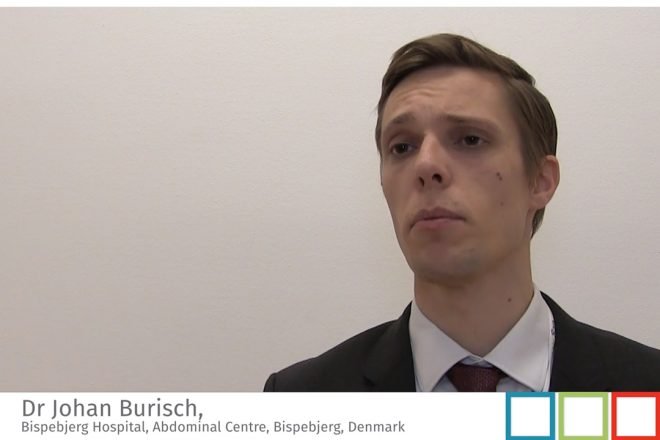Advertisment
UEGW 2018: IBD: from epidemiology to costs and outcome

Dr Johan Burisch (Denmark) reviews data he presented on the cost saving effect of biological therapy in patients with IBD.
Interviews by Hannah Chatfield. Written by Maria Dalby
In of the abstract sessions at UEG Week 2018, Dr Johan Burisch from Copenhagen presented data from the Epi-IBD population-based inception cohort which shows that the overall direct healthcare costs for IBD are decreasing in the biological era. The analyses comprised a total of 1,362 IBD patients treated in 31 centres in 20 European countries, and data was collected on the cost of procedures, treatments (biological and standard treatments), hospitalisation and surgery. Over a follow-up period of five years the annual costs for CD decreased from just under 6,000 EUR per patient year to around 3,000 EUR per patient year, and the annual cost of CD dropped from around 4,000 EUR to around 2,000 EUR per patient year. During this period the cost of biological and conventional drugs increased in both groups, but costs for hospitalisation, procedures and surgery decreased. The mean total cost per patient decreased across different disease characteristics including penetrating and stricturing CD and left-sided and extensive UC; an increase was seen though in the mean total cost per patient among patients with proctitis. The investigators concluded that although biological therapies are associated with high acquisition costs, they have an overall cost-saving effect in IBD.
In another presentation from Copenhagen, Bobby Lo showed data from a Danish population-based inception cohort of 513 patients diagnosed with IBD between 2003 and 2004 which showed that over a 10-year follow-up period, the indirect costs of IBD did not differ significantly from those in the general population. Data on employment status, sick-leave and social benefits were obtained from national registries and matched by age, sex and municipality with healthy controls at a ratio of 1:20. Among a total of 213 CD patients included, 139 patients (65%) were on sick leave for a median of 8.4 months during the follow up period; among the 300 UC patients, 181 patients (60%) were on sick leave for a median of 5.1 months and the corresponding median sick leave period among healthy controls was 5.7 months (p=0.09 compared with the two IBD groups). Unemployment benefit was paid out for a median of 5.3 months in the CD group and 6.6 months in the UC group, compared with 5.9 months among health controls (p=0.7). The investigators hypothesised that the lack of impact on indirect costs could be a biological era effect, in the sense that in a country like Denmark where people have free and universal access to the healthcare system, current IBD treatments are allowing patients to stay in work.
Primary and secondary loss of response are common features of anti-TNF therapy, and are often dealt with in routine clinical practice by switching to a second, and sometimes even a third anti-TNF agent before switching out of class. Dr Maria José Casanova from Madrid presented an analysis of data from the ENEIDA registry which aimed to investigate the efficacy and safety of sequential use of second and third anti-TNF agents and identify factors for predicting remission or loss of response. A total of 1,122 patients at 59 Spanish centres where included in the analysis. Infliximab was the most common first anti-TNF followed by adalimumab, and conversely adalimumab was the most common second anti-TNF followed by infliximab. Of patients who received a third anti-TNF, half received certolizumab pegol and one third received golimumab. Almost half of patients (45%) treated with a second anti-TNF achieved short-term remission and an additional 35% had a partial response. Factors that were significantly associated with achieving short-term remission with a second anti-TNF were concomitant immunomodulatory treatment (odds ratio [OR] 0.5; 96% CI 0.4, 0.7; p<0.0001) and discontinuing the first anti-TNF due to primary (OR 0.6; 95% CI 0.4, 0.9; p=0.007) or secondary (OR 0.6; 95% CI 0.4, 0.9; p=0.007) loss of response (rather than intolerance). Having UC (rather than CD) (hazard ratio [HR] 1.6; 95% CI 1.1, 2.1; p=0.005) and combination therapy (HR 2.4; 95% CI 1.8, 3; p<0.0001) were significantly associated with loss of response to the second anti-TNF therapy. A total of 71 patients received a third anti-TNF agent before switching out of class; 45% had discontinued their second anti-TNF due to primary loss of response and 39% due to secondary loss of response. Although 55% achieved short-term remission on a third anti-TNF agent, 18% had lost their response after one year and 37% after two years. The investigators concluded that sequential use of a second and third anti-TNF agent was safe but associated with high rates of loss of response.





